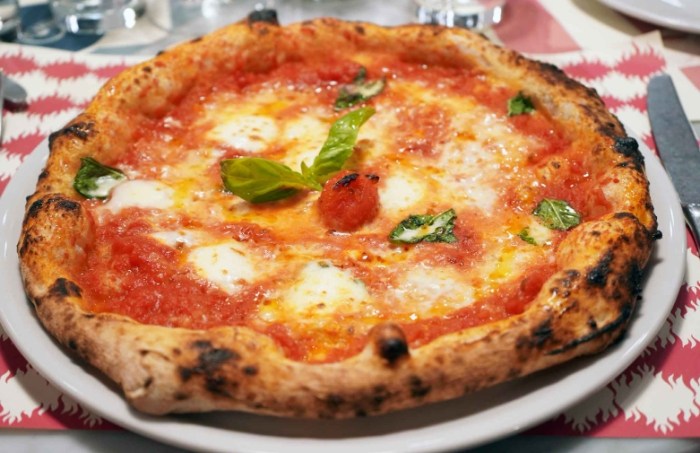Roma Pizza: Authentic Roman-Style Pizza Recipes & Where to Find the Best
Craving authentic Roma Pizza? Discover Rome's best pizza styles - from thin-crust Roman pizza al taglio to classic toppings, where to eat, and how to make traditional Roma Pizza at home!
Table of Contents
Roma pizza, also known as "Pizza Romana" or simply "Roman pizza," is a culinary masterpiece that has captured the hearts and taste buds of locals and visitors alike in the Eternal City of Rome. As an Italian local, I am thrilled to share with you the rich history, intricate craftsmanship, and delightful flavors that make Roma pizza a truly unique and cherished dish. In this comprehensive guide, we will explore the origins of Roma pizza, delve into its core techniques, learn how to make it at home, discover the perfect pairings, and highlight some of the best pizzerias in Rome. So, let's embark on this delicious journey and uncover the secrets of Roma pizza.
History of Roma Pizza

Origins and Evolution
The history of Roma pizza dates back centuries, with roots deeply embedded in the ancient culinary traditions of Rome. Unlike its Neapolitan counterpart, which has a more documented history tied to the city of Naples, Roma pizza evolved over time, influenced by various cultural and historical factors.
Early Influences
The early Roman diet was heavily influenced by the Mediterranean, with staples like wheat, olive oil, and tomatoes playing a central role. Pizza, in its simplest form, was a flatbread topped with these ingredients, often enjoyed by the lower classes as a quick and affordable meal. Over time, as Rome grew into a cosmopolitan hub, the pizza began to incorporate new flavors and techniques from different regions of Italy and beyond.
Modern Development
The modern Roma pizza as we know it today began to take shape in the mid-20th century. Pizzerias in Rome started experimenting with different dough recipes, baking methods, and toppings, creating a style that was distinct from the traditional Neapolitan pizza. Roma pizza is characterized by its thin, crispy crust, which is achieved through a longer fermentation process and a higher baking temperature.
Cultural Significance
Roma pizza has become an integral part of Roman culture, representing the city's vibrant food scene and its commitment to quality and tradition. It is a dish that is enjoyed by people of all ages and backgrounds, whether it's a quick lunch on the go or a leisurely dinner with family and friends. Roma pizza also plays a significant role in Roman social life, with pizzerias serving as gathering places for locals to share stories, laughter, and of course, delicious pizza.
Core Craftsmanship of Roma Pizza

Dough Preparation
The foundation of any great pizza lies in its dough, and Roma pizza is no exception. The dough for Roma pizza is made using a simple yet precise recipe that emphasizes quality ingredients and careful preparation.
Ingredients
- Flour: High-quality Italian "00" flour is typically used for Roma pizza dough. This flour has a fine texture and low gluten content, resulting in a soft and tender crust.
- Water: Fresh, clean water is essential for achieving the right consistency in the dough.
- Yeast: Active dry yeast or fresh yeast is used to help the dough rise.
- Salt: A small amount of salt is added to enhance the flavor of the dough.
- Olive Oil: Extra virgin olive oil is often added to the dough to give it a rich, aromatic flavor and a slightly chewy texture.
Techniques
- Mixing: The ingredients are combined in a large mixing bowl and kneaded until a smooth, elastic dough is formed. This process can be done by hand or using a stand mixer with a dough hook attachment.
- Fermentation: The dough is then allowed to ferment for an extended period, usually 24-48 hours. This slow fermentation process helps to develop the flavor of the dough and gives it a light, airy texture.
- Shaping: After fermentation, the dough is divided into individual portions and shaped into thin, round discs. The dough is then left to rest for a short period before being topped and baked.
Baking Methods
Baking Roma pizza requires a specific set of techniques to achieve the perfect balance of crispy crust and melted toppings.
Oven Selection
Traditional Roma pizza is baked in a wood-fired oven, which reaches temperatures of up to 900°F (482°C). The high heat helps to quickly cook the pizza, resulting in a crispy crust and bubbly, melted cheese. However, modern pizzerias may also use gas or electric ovens that can achieve similar results.
Baking Time and Temperature
Roma pizza is baked for a relatively short period, usually 2-3 minutes, at a high temperature. This quick baking time ensures that the crust is crispy on the outside while remaining soft and tender on the inside.
Placement in the Oven
The pizza is placed directly on the oven floor or a pizza stone, which helps to transfer heat evenly and create a crispy crust. Some pizzerias may also use a pizza peel to slide the pizza in and out of the oven quickly.
Homemade Roma Pizza: A Step-by-Step Guide

Ingredients and Equipment
Making Roma pizza at home is a fun and rewarding experience that allows you to customize your pizza to your liking. Here's what you'll need:
Ingredients
- Dough: 500g "00" flour, 300ml warm water, 7g active dry yeast, 10g salt, 2 tbsp extra virgin olive oil
- Tomato Sauce: 400g canned crushed tomatoes, 2 cloves garlic (minced), 1 tbsp olive oil, 1 tsp dried oregano, salt and pepper to taste
- Toppings: Mozzarella cheese (shredded), fresh basil leaves, sliced tomatoes, sliced mushrooms, sliced onions, etc.
Equipment
- Large mixing bowl
- Stand mixer with dough hook attachment (optional)
- Pizza peel
- Pizza stone or baking sheet
- Rolling pin
- Kitchen scale
- Measuring cups and spoons
Step-by-Step Instructions
Step 1: Prepare the Dough
- In a large mixing bowl, combine the flour, yeast, and salt.
- Gradually add the warm water and olive oil, mixing until a dough forms.
- Knead the dough for 10-15 minutes by hand or using a stand mixer with a dough hook attachment until it becomes smooth and elastic.
- Place the dough in a lightly oiled bowl, cover with a damp cloth, and let it ferment at room temperature for 24-48 hours.
Step 2: Make the Tomato Sauce
- In a small saucepan, heat the olive oil over medium heat.
- Add the minced garlic and sauté for 1-2 minutes until fragrant.
- Add the crushed tomatoes, dried oregano, salt, and pepper. Stir well and bring to a simmer.
- Reduce the heat to low and let the sauce simmer for 15-20 minutes, stirring occasionally, until it thickens slightly.
Step 3: Shape the Dough
- After fermentation, divide the dough into 4 equal portions.
- On a lightly floured surface, roll out each portion into a thin, round disc using a rolling pin. The dough should be about 1/8 inch (3mm) thick.
- Transfer the shaped dough to a pizza peel lined with parchment paper.
Step 4: Add the Toppings
- Spread a thin layer of tomato sauce over the dough, leaving a small border around the edges.
- Sprinkle a generous amount of shredded mozzarella cheese over the sauce.
- Add your desired toppings, such as fresh basil leaves, sliced tomatoes, sliced mushrooms, or sliced onions.
Step 5: Bake the Pizza
- Preheat your oven to the highest temperature possible (ideally 500°F/260°C or higher). If using a pizza stone, place it in the oven to preheat as well.
- Slide the pizza onto the preheated pizza stone or baking sheet using the pizza peel.
- Bake the pizza for 8-12 minutes, or until the crust is golden brown and the cheese is melted and bubbly.
- Remove the pizza from the oven and let it cool for a few minutes before slicing and serving.
Pairing Roma Pizza: Wine and Beverage Recommendations

Wine Pairings
Roma pizza pairs beautifully with a variety of Italian wines, enhancing the flavors of both the pizza and the wine. Here are some wine recommendations to complement your Roma pizza:
Red Wines
- Chianti: This classic Tuscan red wine is made from Sangiovese grapes and has a medium body, high acidity, and notes of cherry, plum, and spice. It pairs well with tomato-based pizzas and meaty toppings.
- Barbera: Hailing from the Piedmont region, Barbera is a light-bodied red wine with bright acidity and flavors of red fruit, such as raspberry and strawberry. It complements lighter pizzas with fresh vegetables and herbs.
- Nero d'Avola: This Sicilian red wine is known for its full body, rich flavors of blackberry and licorice, and smooth tannins. It pairs well with hearty pizzas with bold toppings like sausage or pepperoni.
White Wines
- Pinot Grigio: This popular Italian white wine has a light body, high acidity, and flavors of citrus, green apple, and pear. It pairs well with seafood pizzas or pizzas with light, fresh toppings.
- Fiano di Avellino: From the Campania region, Fiano di Avellino is a medium-bodied white wine with notes of honey, almond, and citrus. It complements pizzas with creamy toppings like ricotta or mozzarella.
- Vernaccia di San Gimignano: This Tuscan white wine has a crisp acidity, flavors of apple and pear, and a mineral finish. It pairs well with vegetarian pizzas or pizzas with a simple tomato sauce and cheese.
Non-Alcoholic Beverages
If you prefer non-alcoholic beverages, there are also several options that pair well with Roma pizza:
- Sparkling Water: A refreshing glass of sparkling water can help cleanse your palate between bites of pizza.
- Iced Tea: Unsweetened iced tea with a squeeze of lemon is a light and refreshing option that complements the flavors of the pizza.
- Fresh Lemonade: Homemade lemonade made with fresh lemons, sugar, and water is a sweet and tangy beverage that pairs well with spicy or savory pizzas.
Regional Specialties: Roma Pizza Across Italy

While Roma pizza originated in Rome, its popularity has spread throughout Italy, with each region putting its own unique spin on the classic dish. Here are some regional specialties that showcase the diversity of Roma pizza across Italy:
Lazio (Rome)
- Pizza al Taglio: This type of Roma pizza is sold by the slice and is often rectangular in shape. It is typically topped with simple ingredients like tomato sauce, mozzarella, and fresh basil, making it a popular street food option.
- Pizza Bianca: A white pizza without tomato sauce, Pizza Bianca is topped with olive oil, salt, and sometimes rosemary. It has a soft, chewy crust and is often enjoyed as a snack or breakfast item.
Campania (Naples)
- Pizza Margherita: While not strictly a Roma pizza, the Pizza Margherita is a classic Neapolitan pizza that has influenced the development of Roma pizza. It is topped with tomato sauce, mozzarella, and fresh basil, representing the colors of the Italian flag.
- Pizza Marinara: Another Neapolitan specialty, the Pizza Marinara is topped with tomato sauce, garlic, oregano, and olive oil. It has a simple yet flavorful profile and is often enjoyed as a light meal or appetizer.
Tuscany (Florence)
- Pizza alla Fiorentina: This Tuscan-style pizza is topped with spinach, ricotta cheese, and a poached egg. It has a creamy and savory flavor profile and is a popular choice for brunch or lunch.
- Pizza con Salsiccia e Friarielli: A hearty pizza topped with sausage and broccoli rabe, this dish showcases the bold flavors of Tuscan cuisine.
Sicily (Palermo)
- Pizza con Sarde: This Sicilian pizza is topped with sardines, onions, raisins, and pine nuts. It has a unique combination of sweet and savory flavors that reflects the island's diverse culinary influences.
- Pizza con Pistacchi: A pizza topped with crushed pistachios, ricotta cheese, and honey, this dessert pizza is a sweet and indulgent treat.
Top Roma Pizza Restaurants in Rome
If you're planning a trip to Rome and want to experience the best Roma pizza the city has to offer, here are some top pizzerias that you won't want to miss:
1. Pizzarium
- Location: Via della Meloria, 43
- Specialties: Pizzarium is known for its creative and unique pizza toppings, such as truffle cream, porcini mushrooms, and gorgonzola cheese. The pizza is sold by the slice, making it a great option for a quick and delicious snack.
- Why Visit: Pizzarium has been consistently ranked as one of the best pizzerias in Rome, offering high-quality ingredients and innovative flavor combinations.
2. Da Remo
- Location: Piazza di Santa Maria Liberatrice, 44
- Specialties: Da Remo is a classic Roman pizzeria that has been serving up delicious pizza since 1947. Their pizza is known for its thin, crispy crust and traditional toppings like tomato sauce, mozzarella, and fresh basil.
- Why Visit: Da Remo is a popular spot among locals and tourists alike, offering a lively atmosphere and authentic Roman pizza.
3. Antico Forno Roscioli
- Location: Via dei Chiavari, 34
- Specialties: Antico Forno Roscioli is a bakery and pizzeria that specializes in traditional Roman bread and pizza. Their pizza is made with high-quality ingredients and baked in a wood-fired oven, resulting in a delicious and authentic flavor.
- Why Visit: In addition to their pizza, Antico Forno Roscioli also offers a variety of freshly baked breads, pastries, and other Italian specialties.
4. Gino Sorbillo
- Location: Via dei Tribunali, 32
- Specialties: Gino Sorbillo is a famous Neapolitan pizzeria that has expanded to Rome. Their pizza is made with a thin, crispy crust and traditional Neapolitan toppings like tomato sauce, mozzarella, and fresh basil.
- Why Visit: Gino Sorbillo is known for its high-quality ingredients and authentic Neapolitan pizza-making techniques, making it a must-visit for pizza lovers.
5. Pizzeria La Gatta Mangiona
- Location: Via Ozanam, 30
- Specialties: Pizzeria La Gatta Mangiona is a family-owned pizzeria that offers a wide variety of pizza toppings, including both traditional and creative options. Their pizza is made with a thin, crispy crust and baked in a wood-fired oven.
- Why Visit: Pizzeria La Gatta Mangiona is known for its friendly service, cozy atmosphere, and delicious pizza, making it a great choice for a family dinner or a night out with friends.
Q&A
1. What is a Roma pizza?
Roma pizza, also known as "Pizza Romana" or "Roman pizza," is a style of pizza that originated in Rome, Italy. It is characterized by its thin, crispy crust, which is achieved through a longer fermentation process and a higher baking temperature. Roma pizza is typically topped with simple ingredients like tomato sauce, mozzarella, and fresh basil, although regional variations may include other toppings.
2. Who makes Roma pizza?
Roma pizza is made by skilled pizzaioli (pizza makers) in pizzerias throughout Rome and other regions of Italy. These pizzaioli have honed their craft over years of practice, using traditional techniques and high-quality ingredients to create delicious and authentic Roma pizza.
3. What does a Romana pizza have on it?
A Romana pizza typically has a thin, crispy crust topped with a simple tomato sauce, shredded mozzarella cheese, and fresh basil leaves. However, regional variations may include other toppings such as sliced tomatoes, mushrooms, onions, or even seafood. The key to a great Romana pizza is the balance of flavors and textures, with the crust providing a satisfying crunch and the toppings adding depth and complexity.
4. What is the difference between Neapolitan and Romana pizza?
While both Neapolitan and Romana pizza are beloved styles of Italian pizza, there are some key differences between the two:
- Crust: Neapolitan pizza has a thick, soft crust with a slightly charred edge, while Romana pizza has a thin, crispy crust that is crunchy all the way through.
- Baking Method: Neapolitan pizza is typically baked in a wood-fired oven at a high temperature for a short period, resulting in a soft and chewy crust. Romana pizza is also baked in a wood-fired oven but at a slightly lower temperature for a longer period, allowing the crust to become crispy.
- Toppings: Neapolitan pizza often features simple toppings like tomato sauce, mozzarella, and fresh basil, while Romana pizza may include a wider variety of toppings, including vegetables, meats, and cheeses.
- Region: Neapolitan pizza originated in Naples, while Romana pizza originated in Rome.
In conclusion, Roma pizza is a culinary treasure that embodies the rich history, culture, and flavors of Rome. Whether you're enjoying a slice on the streets of the Eternal City or making it at home, Roma pizza is sure to delight your taste buds and leave you craving more. So, the next time you're in the mood for pizza, give Roma pizza a try and experience the magic of this classic Italian dish.